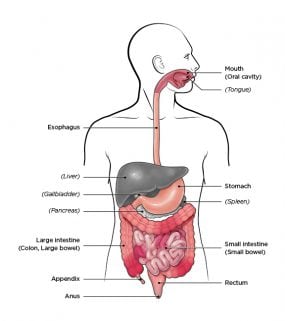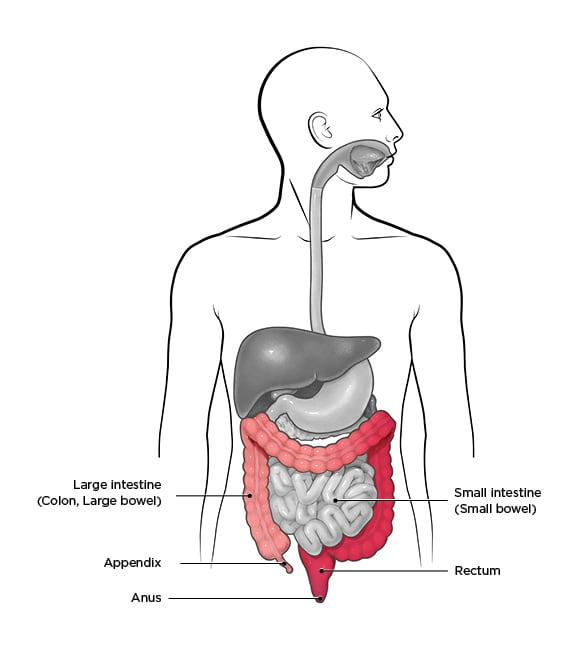Inflammatory bowel disease (IBD): It is a multifactorial condition characterized by chronic inflammation of the gastrointestinal tract. It encompasses two syndromes - Crohn’s disease (CD) and ulcerative colitis (UC). IBD tends to run in families. It is more common in whites and Ashkenazi Jews. Smoking predisposes to CD, while it has an apparent protective effect in UC. HLA A2, B27 are associated with CD while HLA-Bw35, B5 and B27 are associated with UC. Mutations in NOD2, involved in innate immunity, carries a high risk of developing CD. NOD2 recognizes components of the bacterial cell wall and elicits an NF-κB response, and also mediates the release of defensins.


IBD is caused by abnormal and exaggerated inflammatory response in a genetically susceptible individual, with recruitment of inflammatory cells like neutrophils, lymphocytes, macrophages and mast cells into the gastrointestinal tract and release of cytokines and monokines, free radicals,TGF beta , leukotrienes, enhanced CD8+ cytotoxic response and decreased suppressor T cell response, that sets off chronic inflammation. The trigger to such an immune response is not definitely known.
| Crohn’s disease | Ulcerative colitis |
| Can affect any part of the GIT, from mouth to anus. Most commonly involves ileum and colon | Affects the rectum and colon |
| Patchy areas of disease but affects entire wall thickness (transmural), interspersed with healthy areas | Affects areas superficially (mucosa and submucosa) but continuously, starting from the rectum and spreading to involve adjoining colon. |
| Biopsy shows ulceration extending deep to the submucosa; non-caseating granulomas, crypt abscesses (look for neutrophil collections), submucosal edema, neuronal hyperplasia, thickened and fibrosed bowel wall. pseudopolyps are less common | Biopsy shows diffuse mononuclear inflammatory infiltrate in the lamina propria, pseudopolyps (composed of granulation tissue, inflamed regenerating mucosa and multinucleated giant cells), crypt abscesses, plasma cells; absence of granulomas, neuronal hyperplasia, submucosal edema or thickened bowel |
| Strictures, fistulas and sinuses may form | No strictures, fistulas or sinuses |
| Skip lesions and serpentine ulcers seen | Continuous involvement hence no skip lesions; superficial, not serpentine ulceration |
| Cobblestone appearance due to healthy mucosa interspersed between depressed, ulcerated areas | Absence of cobblestone appearance of mucosa |
| Mesenteric fat wrapping seen | Absence of fat wrapping |
| Anti-Saccharomyces cerevisiae antibodies or ASCA+ | Anti-Saccharomyces cerevisiae antibodies or ASCA mostly absent |
| p ANCA typically negative | p ANCA + |
Clinical features include persistent diarrhea, abdominal pain and cramping, blood in stools or rectal bleeding, weight loss, fatigue. The clinical course is marked by flare-ups and remissions .
Complications include perforation (UC and CD), toxic megacolon (UC), iliac vein thrombosis, colon cancer, lymphoma and appendicitis (UC). Vit B12 deficiency may occur in CD.

Extraintestinal manifestations are common and include migratory polyarthritis, sacroiliitis, ankylosing spondylitis, pyoderma gangrenosum, clubbing of fingertips, primary sclerosing cholangitis (more in UC), pericholangitis, oxalate stones (CD), uveitis and cholangiocarcinoma (rare).

Diagnosis is by a combination of clinical features plus endoscopy and imaging such as CT (with oral and/or intravenous contrast; avoid oral contrast in suspected perforations) and MRI. Findings in CD include wall thickening >3mm), mucosal hyperenhancement, “target sign”, engorged vasa recta or “comb sign”, fistulas, abscesses and creeping fat stranding in chronic CD. Endoscopy is preferred over CT/MRI in UC except in the presence of toxic megacolon or perforation, in which case CT is preferred. CT findings include thinning of the colonic wall, luminal distension, and pneumatosis, free intraperitoneal gas is seen in perforation. MRI is preferred in personal disease.

Treatment is with corticosteroids like prednisone, aminosalicylates like mesalamine or 5-ASA or sulfasalazine (helps maintain remission in UC), metronidazole, immunosuppression with azathioprine or mercaptopurine (severe or steroid resistant IBD), methotrexate (reduces inflammation), biologics or monoclonal antibodies like infliximab, adalimumab and etanercept; nutritional supplementation, supportive therapy like loperamide for diarrhea, bismuth enemas in UC and colectomy. Paradoxically, patients treated for autoimmune diseases with anti-TNFα agents, especially etanercept, have an increased risk of developing IBD.
Patients with IBD are at increased risk of developing colon cancer and hence should be monitored by colonoscopy after 8-10 years of disease. Colonoscopy in IBD is done at an interval of every 1-2 years. Flat or polypoid dysplastic lesions may be seen and should be biopsied.
Ogilvie syndrome or acute colonic pseudo-obstruction: It is a non-mechanical pseudo-obstruction with loss of colonic motor activity and colonic distension, seen in the setting of critical illnesses like AMI, sepsis, CCF, pneumonia, trauma or surgeries like total hip replacement, cardiac surgery, abdominal surgery etc . Severe electrolyte imbalances and medications like anticholinergics, steroids and opioids can precipitate Ogilvie syndrome. It presents with massive abdominal distension and pain, nausea, vomiting, fever and leukocytosis. Perforation may occur and is most commonly seen in the cecum. Imaging studies show massively dilated colon, especially cecum and right colon. Water-soluble contrast enema can help in diagnosis as well as in decompression of the colon. Treatment is mainly supportive. Neostigmine, colonic decompression and cecostomy may help.
Volvulus: Volvulus is abnormal rotation or twisting of the colon along it’s mesentery. It is seen in the sigmoid colon and cecum. It is dangerous as it causes a closed-loop obstruction with impaired venous return, bowel ischemia and perforation with peritonitis. Risk factors include long mesentery, malrotation, pregnancy, adhesions, neuroleptic drugs, Chagas disease, Duchenne muscular dystrophy, high-fibre diet, chronic constipation and Hirschsprung disease. Volvulus presents with abdominal distension, vomiting, pain, fever, constipation and obstipation (failure to pass flatus). Cecal volvulus presents as a small-bowel obstruction. Less commonly, volvulus may involve the stomach or small intestines (associated with malrotation in children). Imaging studies show classic “bent inner tube” or “coffee bean” sign. The cecum may be seen at abnormal locations like upper abdominal quadrants. Barium enema shows “bird’s beak” sign. In sigmoid volvulus, sigmoidoscopy is done as a diagnostic and therapeutic measure as it achieves decompression of the colon and possible resolution of the volvulus. A rectal tube can be passed to help decompression. For complicated cases, surgical intervention is required in the form of resection (preferred) or sigmoidopexy. Hartmann procedure is done for bowel perforations. In cecal volvulus, cecopexy or cecal resection/ right hemicolectomy with ileostomy or colostomy is done. Endoscopy is not done for cecal volvulus as there is no therapeutic benefit.
Hematochezia: Hematochezia is the passage of fresh blood per anus, usually in or with stools. Source is typically rectum or colon. Rarely, massive upper gastrointestinal bleeding may present as hematochezia. In elderly, diverticulosis and AV malformations (angiodysplasias) are the most common causes. Other causes are hemorrhoids, anal fissure, colon cancer, ischemic colitis and IBD. Typically colonic bleeds are mixed with stools whereas rectal bleeding covers the stool or is on the toilet paper. In infants, hematochezia is caused by necrotizing enterocolitis and midgut volvulus. In older children, Meckel’s diverticulum, intussusception, IBD and juvenile polyps commonly cause hematochezia. It may also be seen in infections like Campylobacter, shigellosis and amoebiasis.

Sign up for free to take 5 quiz questions on this topic